The Innovator's Prescription: Raising Your Return on Innovation Investment
Each company has an intrinsic innovation effectiveness curve. Here are three ways to lift it.
 |
|
Illustration © Dan Page, 2004 |
When Philip A. Marineau was named CEO of the San Francisco–based company in late 1999, he offered up a one-word solution: innovation. Mr. Marineau was a vaunted “idea guy”; as head of PepsiCo Inc.’s North American business, he had championed the launch of Pepsi One cola, a product that revitalized Pepsi’s lackluster diet segment. At Levi’s, he wasted no time in dispatching designers to Europe and Asia to troll plazas and pachinko parlors for ideas. Spending on new product development increased, and a stream of new products began to roll off the apparel company’s assembly line — Type 1 Jeans, Engineered Jeans, and the Dockers Mobile Pant, which sported pockets for cellular telephones, pagers, and PDAs.
A success story? Not quite: The new jeans, although popular overseas, never caught on in the U.S., and the Dockers Mobile Pant didn’t mobilize consumers. Levi’s announced a net loss of $40 million for the first half of 2003, and global sales fell to $1.8 billion.
Levi’s is not alone. Academic and popular sources have been filling the business world with paeans to innovation. They have championed the search for the “new new thing,” recommended the hiring of “cool hunters” who can uncover big profitable ideas, and suggested that companies can spend their way to novelty-premised growth. Charles I. Jones of Stanford University and John C. Williams of the Federal Reserve Bank of San Francisco argued in 1997, for example, that the “right level” of R&D spending by U.S. companies to ensure consistent levels of growth is “more than four times larger than actual spending.” And a 2001 special report in Business Week opined that “with the rate of return on R&D so high … the country should be spending a lot more.”
Yet time and again, companies have found that spending more on innovation does not necessarily translate into accelerating sales, share, or profits. In 1995, Polaroid began pumping money into R&D in the core imaging business and significantly increased new product launches, but it was not enough to keep the company out of Chapter 11 in 2001. Maytag began making increases in R&D in 2001, yet through 2003 sales continued to slip.
Aggregate statistics support the anecdotal findings. Over the past decade, the number of new consumer products introduced in the United States has grown at a compound annual rate of about 7 percent, to 32,000 a year, according to the research group Productscan Online, while sales have grown only about 3 percent. Christoph-Friedrich von Braun, in his 1997 study The Innovation War, analyzed 30 Global 500 firms and found almost no correlation between increased R&D spending and improvement in profitability. Our own analysis of global personal-care and consumer health-care companies showed no clear correlation between R&D spending as a percentage of sales and growth in revenues or profitability.
Profitable innovation, in other words, cannot be bought. Simply spending more usually leads to a waste of resources on increasingly marginal projects. The solution to innovation anemia is not to boost incremental spending, but to raise the effectiveness of base spending — to increase the return on innovation investment, lifting the firm’s “ROI2.”
How? The answer can be found deep within the firm’s microeconomic fundamentals. Through work with clients in a number of industries, including recent transformational engagements for several leading global consumer and health-care companies, we have identified three principles we believe can improve the return on innovation investment of any company engaged in the development of new products or services. We call these principles the three pillars of innovation.
Pillar One: Understand Your Innovation Effectiveness Curve
At its simplest level, innovation is embodied by a product or service offering that contains a significant element of newness. “New” may not mean entirely new to the world, of course, since line extensions of existing brands — Colgate Whitening toothpaste, White Chocolate Reese’s Peanut Butter Cups — are a frequently profitable form of innovation. True innovation can take the form of a new product, technology, process, content, or even the presentation and marketing of an existing product or service.
Our recent work has shown that incremental innovation investments are subject to diminishing returns — in other words, each additional dollar spent on new product development ultimately yields a lower and lower return. This observation passes the test of common sense: Spending beyond a certain point on any development portfolio should result in lower returns, since a company will naturally invest in the best projects first, the next-best after that, and so on, until it is tossing good money away on more and more dubious projects. Exhibit 1 illustrates this phenomenon by contrasting the innovation ROI of two companies with very different portfolios. We call the marginal return on innovation investment the innovation effectiveness curve. The larger the area under the curve, the better the firm’s innovation effectiveness.
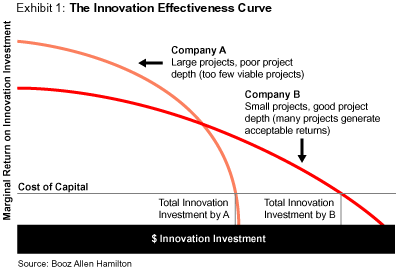
Each company — and possibly each separate business unit — has an intrinsic innovation effectiveness curve, which can be drawn easily by plotting the ROI2 of each project in the development pipeline and the cumulative innovation investment. The curve is very important: It predicts the company’s future revenue, profit, and growth derived from new products. Moreover, even though projects within a portfolio change, we have found that a company’s innovation effectiveness curve is surprisingly stable: It does not change substantially over time.
The law of diminishing returns in innovation effectiveness explains the numerous cases in which increases in R&D spending do not produce significant lifts in sales or growth. These companies are not raising but rather “riding the curve” — increasing their spending on idea generation and new product development, without altering the processes, systems, structures, or capabilities that determine their ROI2.
A multiyear benchmarking study we conducted in the consumer health-care industry, involving most of the sector’s major global companies, showed that effectiveness can vary widely even within a single industry. We explored the sales of new products, defined as products launched within the past three years, relative to the company’s total R&D spending over that same period. We discovered that companies and business units showed remarkable consistency, year after year, in their individual return on innovation investment. Moreover, we found the return on innovation investment of the best performers to be twice the industry average, and more than 10 times that of the worst performers. (See Exhibit 2.)
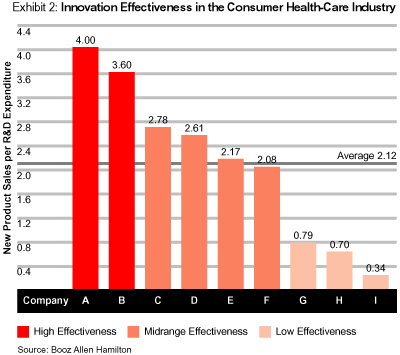
Our study found that innovation effectiveness does not correlate well with company size or with the scale of R&D investment. In fact, the top innovation performers tended to have lower relative R&D expenditures. The most effective cohort in our consumer health-care study (those companies with the highest new product profit per dollar spent on R&D) averaged 4.8 percent R&D spending as a percent of sales, while the least effective cohort averaged 5.9 percent.
These findings have considerable implications for companies intent on improving their return on innovation investment. Given that each firm (or unit) has an intrinsic curve that limits the return it achieves from marginal investment in innovation, and that companies within the same industry can differ wildly in their innovation effectiveness, it is clear that firms must raise the innovation return curve.
The results of raising innovation effectiveness can be profound: Companies increase the return on their base innovation spending (more high-quality new products, faster, and at lower cost) and get an option to invest more while maintaining a high level of return. The height of the curve defines the company’s overall innovation effectiveness. Which leads us to our second pillar:
Pillar Two: Master the Entire Innovation Value Chain
Raising the inherent innovation effectiveness curve requires senior management to understand that innovation is not a discrete activity, but a multifunctional capability that requires several types of competencies. In fact, executives ought to look at successful innovation as the expression of a well-organized value chain or value web. An innovation capability requires owning or sourcing four critical sets of capabilities: ideation, project selection, development, and commercialization. Since a chain is only as strong as its weakest link, the innovation effectiveness curve cannot be raised unless all four elements are mastered. (See Exhibit 3.)
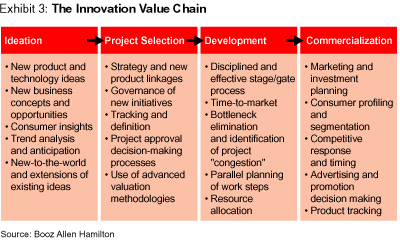
This value chain is relevant for any development process, whether for consumer products, industrial equipment, or services. The best practices adopted by superior innovators along each link of the chain also, in our experience, transcend industry boundaries.
Ideation. Superior innovators create and institutionalize a direct link between strategic priorities and idea generation. They demonstrate market insight by understanding both how much novelty the market wants and will absorb, and how the right new ideas can create such benefits as category growth and gains in market share.
One of the crucial elements of successful idea generation is an advanced market-insight capability. Rapid identification of and reaction to emerging consumer trends enable a company to be first to market with new product introductions. Superior innovators continuously monitor customer insights for inspiration. They have a flexible ideation process that embodies the philosophy of 19th-century rail mogul Cornelius Vanderbilt, who was known for entertaining any crackpot who wanted to see him because “you never know where a good idea comes from.” Best-in-class innovators maintain a large pool of ideas and are reluctant to kill anything before significant investment decisions have to be made. After all, ideas are (almost) free.
Idea generation is both art and science. In the world of consumer products, it functions along two dimensions: consumer needs and technology. Innovating along one dimension only limits opportunity and return. Ideas that address new market needs and are based on existing technology can be replicated easily and do not result in long-term sustainable advantage; new technologies that address an existing market need typically cause a fierce competitive reaction (often in the form of price reductions) from incumbent competitors, deteriorating profits for all players. Innovations that are considered “breakthroughs” — those that lead to outsized return on investment and sustainable profits — are innovative along both dimensions. Examples include such home runs as Listerine PocketPaks breath freshening strips and the Apple iPod digital music player. (See Exhibit 4.)
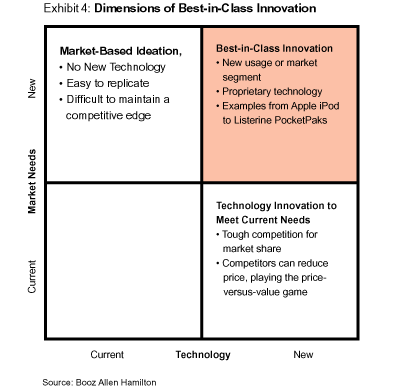
Project Selection. At some point, the large pool of ideas must be funneled into a smaller pond of funded projects. In many companies, this is where the innovation value chain breaks down. Our benchmarking study showed that the governance of new initiatives and the management of new product portfolios are usually misunderstood and underdeveloped. We have seen very few companies in which these capabilities were fully developed and properly applied.
Although companies are frequently criticized for missing good ideas — in the way that Levi Strauss missed the trend toward fashion jeans — a mirror problem often goes unrecognized: accepting too many “bad” ideas among the good ones. Overly lenient companies waste money on projects that never reach launch or that fail shortly after they reach the marketplace. Although proliferating launches may provide them some successes and gain the firms a reputation for innovation, their program is typically quite expensive and is characterized by high R&D spending as a percentage of sales, and low probability of success for projects in the portfolio.
A major cause of missteps in project selection is the silo-ization of ventures; too often, investment decisions are made individually. Yet because all new product candidates are competing for the same pool of resources (both people and dollars), each should be ranked within the context of the whole portfolio.
The organizations with the highest ROI2 don’t use NPV as the sole criterion for project ranking, but incorporate a number of relevant metrics. These frequently include strategic fit, risk-adjusted NPV, new product portfolio balance and prioritization, and current and near-future resource availability by geography and by skill or functional area. In addition, advanced valuation methodologies — such as decision trees, simulation, and real options — can aid decision making by screening out “bad” projects early, and by limiting innovation investments on projects that never get launched, thus focusing the organization on the right opportunities and significantly shortening time-to-market.
It is also important to have a governance structure in place for new initiatives that unambiguously defines how project portfolio decisions are made. Supporting cross-functional organizational processes are required to ensure that the information needed for decision making is available. Senior management involvement in project approval, termination, and portfolio decision making is also essential for rapid and effective new product introduction.
Development. Organizations with high ROI2 put a project through its paces quickly, which allows them more flexibility in selecting a launch date and more time to devise and execute the commercialization plan. It also keeps spending down. Time-to-market is more critical for some projects than others; projects facing an imminent competitive threat obviously require the speediest development. We have found that delays in new product introductions directly affect development costs and returns. This last point is striking: In some categories, such as the relaunch of a prescription-only medication in the over-the-counter marketplace, a launch that takes place even a scant six months after a competitor’s launch can result in hundreds of millions of dollars of lost NPV.
Efficient project management has much in common with efficient manufacturing: It eliminates waste and duplication. The most efficient companies in our survey were lean, with strong cross-functional teams including manufacturing and R&D, and they tended to run processes in parallel; less efficient competitors insisted on step-by-step execution. Yet, despite the importance of time-to-market to innovation returns, at many companies the majority of projects tend to run seriously behind schedule, Booz Allen’s research has shown. Exhibit 5 illustrates a fairly typical time-to-market performance (this one for an engineered products company): The vast majority of projects are running late.
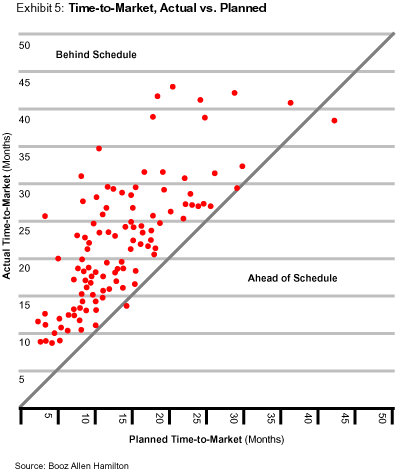
Commercialization. Given the siloed architecture of many large organizations, product development and marketing often lead a disconnected, even antagonistic coexistence. Perhaps nothing is more common within the walls of an R&D shop than to hear developers lament that their new product would have been a blockbuster “if only marketing hadn’t dropped the ball.”
Best-in-class innovators involve marketing early in the development process. Equally critical, and even more often neglected, is the need to turn commercialization itself into a core capability. Two prominent components of this capability are the ability to manage the supply chain to ensure that products are where they need to be when they’re needed, and to promote and market the product intelligently. The best consumer products firms coordinate launch timing with retailers to take into account such factors as shelf-reset cycles and category seasonality; they also arrange optimal promotion packages to maximize the “news value” of the product.
A true sales forecasting capability is also critical. It’s rarely done right, in part because incentive structures often encourage marketing personnel and field representatives alike to be too optimistic in their projections.
The breadth of internal capabilities required to deliver best-in-class innovation and above-average return on innovation investment is wide indeed. But no company can be superior at everything. Hence, the final pillar of innovation:
Pillar Three: Don’t Do It All Yourself
A company does not have to master all innovation capabilities itself. Just as best-in-class companies manage increasingly extended supply chains, superior innovators are learning to outsource segments of the innovation value chain.
A close look at some of the recent breakthrough innovations in the consumer product world will reveal that very few of them were developed inside the largest consumer product companies. Consider Procter & Gamble’s Crest SpinBrush, a battery-operated toothbrush that sells for about $5 in Wal-Mart, Walgreen’s, and other major retailers. Since its launch in 2000, the SpinBrush has become the best-selling toothbrush in the U.S., manual or electric, contributing a robust $200 million in sales to Procter & Gamble in its last fiscal year. Yet, despite P&G’s $200 million annual R&D budget, the idea for the product did not originate with the Cincinnati behemoth. It came from a quartet of Cleveland inventors whose previous claim to fame had been a motorized lollipop. Pfizer’s ubiquitous Listerine PocketPaks — the film-thin strips of breath freshener that overshot their first-year sales target by a factor of three — similarly did not originate in the company’s suburban New Jersey R&D labs. The PocketPaks design was based upon a confection technology long marketed in Japan.
Although some consumer companies continue to believe that innovation can come only from within, a growing body of evidence from other industries and researchers supports an alternative view. One study launched by the consulting firm Delphi Pharma in 2002 looked at the return on R&D investment in the pharmaceutical industry; large pharma companies are among the biggest development spenders on the planet. The study confirmed our research: In this industry as in all others we’ve explored, higher R&D spending did not correlate well with higher new product sales. But this study went further, advising pharma companies to rely more upon outsourced, third-party-generated innovation as a means to increase ROI.
As Harvard Business School Professor Clayton Christensen has observed, there are significant structural reasons that large companies often miss market developments: New markets are too small, at first, to interest major players; margins tend to be lower than they might like; new products often cannibalize a company’s established cash cows. Moreover, as London Business School professors Costas Markides and Paul Geroski have pointed out, large companies, so successful at scaling up mass markets, often lack the skills to pioneer a new market from scratch. (See “The Innovator's Prescription: The Art of Scale,” Summer 2004.) There also is a flaw in the methods by which most companies go about developing new products. Focus groups and surveys elicit consumer opinions, but people can’t know what they don’t know. In a world where Coke is the only beverage, what consumer is going to say that he or she really wants a little blue-and-silver can with taurine in it (i.e., the blockbuster Red Bull energy drink)? “There will always be advantages to size and scope,” strategist and author Gary Hamel has said, “but the industrial company was built for optimization, not innovation.”
Nevertheless, recently some forward-thinking companies have shown unprecedented openness to new ideas. P&G CEO Alan G. Lafley said he would like to see half the new ideas in his company come from the outside, up from the current 20 percent. A new company-wide initiative called “Connect & Develop” was designed to rev up Procter’s innovation engine and allow the company to access external ideas. P&G is explicitly trying to replicate the success of the SpinBrush on a larger scale. P&G’s working methodology at present is to focus on “network nodes,” which are natural communities of idea sources, linked by affinities. P&G alumni form one such node; Web-based idea exchanges such as InnoCentive and NineSigma form another.
Companies are both inspiring and responding to a shift in academic thinking about innovation. Harvard Business School professor Henry Chesbrough recently wrote Open Innovation: The New Imperative for Creating and Profiting from Technology (Harvard Business School Press, 2003) specifically to address the issue of technology innovation models. Although “closed innovation (inventing and exploiting technologies in-house) worked well for decades at industrial powerhouses such as GE, DuPont, and AT&T’s Bell Labs, Professor Chesbrough points to several economic and social trends that are prompting the shift toward open models, including the greater availability of venture capital and a more entrepreneurial mind-set among scientists and large firms. Professors Markides and Geroski have suggested that large firms can refashion themselves into networks of independent agencies ready to pounce on new markets and opportunities as they flash into being. “Established firms must create, sustain, and nurture a network of feeder firms — young, entrepreneurial companies that are busy colonizing new niches,” they have written in strategy+business.
Despite the academic fervor for outsourcing, though, companies need to think rigorously about what can be sent outside the four walls. Although, as a syndrome, “not invented here” is destructive, the impulse to keep control can be rational. Our experience with successful outsourcers persuades us that the innovation value chain presents natural opportunities for openness.
The first link in the chain, idea generation, is clearly ripe for outsourcing; a company should cast as wide a net as possible for ideas. By contrast, the second link, project selection, cannot be outsourced. This critical step speaks to the heart of a firm’s strategy and its vision for its business — its corporate soul, if you will. There are few conceivable means by which a company can outsource its selection of investment opportunities and still remain an entity in any but the vaguest sense of the word.
Link three, development, can certainly be outsourced. Taking an idea from concept to tangible product or service involves a multifunctional set of technical and managerial skills. Some companies, such as Johnson & Johnson’s McNeil Consumer & Specialty Pharmaceuticals division, excel at this; others do not. To the extent a firm can find a product developer outside its walls that can speed up its time-to-market and execute formulation and product creation, there is no reason this capability has to remain in-house. Moreover, with superior product management skills, portions of product development certainly can move outside.
The final link in the innovation value chain, commercialization, cannot really be outsourced. Commercialization is the execution of the strategic vision for the product, and as such is an expression of the firm’s strategy. Although portions of the commercialization process have been outsourced for decades (e.g., advertising campaigns, market research), key decisions about a product’s goals, placement, pricing, rollout, features, and so forth, are intimately linked to a company’s core identity and are too vital to surrender to outsiders.
The Payoff
Methodically improving capabilities may not sound sexy, but there are vivid examples of companies that have done it and reaped significant rewards. Take Apple Computer. During founder Steve Jobs’s hiatus in the early 1990s — when he was off leading the digital animation house Pixar — Apple pursued a new product strategy of launching nondescript versions of older models and me-too clones of IBM/Microsoft boxes. Gone was Apple’s original positioning as a cool-machine kind of place whose products appealed to college kids and graphic artists. After Mr. Jobs returned in 1997, he retooled the innovation engine, fired a number of engineers, and shook up the entire development process. He listened to the market, reorganized, and in short order launched a string of exciting, successful new products, including the iMac, the iBook, and the iPod digital music device. Mainly as a result of its strong new products, Apple’s revenues were up 36 percent in the fourth quarter of 2003. Mr. Jobs improved innovation effectiveness by focusing on capabilities, not spending.
A similar success story appears to be unfolding at the Hershey Foods Corporation. For decades, the legendary candy maker was riding its perennial Reese’s, Hershey’s, and other brands on a path to obsolescence. But starting in 2001, new president Richard Lenny launched a sweeping new product initiative. In addition to slashing overhead and making operational changes, Mr. Lenny instituted a radically stepped-up innovation program. The result was a stream of new products — 30 in 2003 alone — including the FastBreak snack bar, Reese’s and Hershey’s Kisses Limited Editions, and Sugar Free lines. Sales were up 3 percent in the second quarter of 2003. Yet all this innovation was accomplished without any change in the company’s R&D budget.
As Apple and Hershey demonstrate, a wide range of companies can realize better returns on their spending for growth. It is only after they do the hard work of improving effectiveness that they should spend more to earn more.![]()
|
Innovation’s New Performance Standard |
|
After five years of retrenchment and cost cutting, senior executives across a variety of industries share the conviction that innovation — the ability to define and create new products and services and quickly bring them to market — is an increasingly important source of competitive advantage. Booz Allen Hamilton surveyed 50 companies in early 2004, and more than 90 percent of top managers at those firms, in fields such as aerospace, automotive products, pharmaceuticals, and telecommunications, said innovation was critical to achieving their strategic objectives. Indeed, for the next two years alone, they are setting aggressive performance goals for their innovation and product-development organizations, targeting 20 to 30 percent improvements in such areas as time-to-market, development costs, product cost, and customer value. But a vast disconnect lies between hope and reality. Our survey shows that companies are only marginally satisfied that their current innovation organizations are delivering their full potential. Worse, executives say that only half of the improvement efforts they launch end up meeting expectations. Several waves of improvements in innovation and product development have already substantially enhanced companies’ ability to deliver differentiated, higher-quality products to markets faster and more efficiently. However, the degree of success achieved has varied greatly among companies and even among units within individual companies. The survey confirmed what we have observed in our consulting work: The differences in success stem from the difficulty of managing change in the complex processes and organizations associated with innovation and product development. The survey also suggested that four factors make or break innovation programs. Senior Leadership Support. Clear and unwavering support from senior management ranks first among factors that determine a company’s ability to effect complex change. By a two-to-one margin over other considerations, competing internal priorities and insufficient time and resources — issues that can be resolved only with top management guidance — were cited as the chief barriers to achieving improved innovation and product development performance. Continuous Improvement. The survey suggests that a company’s overall approach to innovation, rather than the amount of time and money it spends on process improvements, correlates with the results obtained. Companies with an established process for continuous improvement coupled with periodic transformational initiatives had the best overall results and the highest level of satisfaction in the progress of their innovation initiatives. Still, some 40 percent of companies either have no formal process for improving performance or describe their improvement efforts as opportunistic or ad hoc. Organization as Enabler. Different models for innovation programs work effectively for different companies in different industries. But, although variety may be the spice of life, there is a downside: Since there is no standard innovation-organization model, many companies end up changing models frequently in search of better performance. Fifty-five percent of the companies surveyed said they had reorganized their innovation organizations during the prior two years. The traditional “functional” organization model for innovation was aligned according to activities, such as R&D, marketing, and operations. But this model’s inherent weaknesses — it hinders customer understanding and time-to-market — generated a mass migration toward “product-focused” organizations, in which resources from relevant functions are assigned to a specific product or product group. Realizing, however, that with the product focus they risk losing technical excellence and functional engineering standards, many companies have begun to use a third model. The overall trend now seems to favor “heavyweight” program-management organizations. These combine strengths from the functional and product-focused models; personnel increasingly are reporting both to a functional head (for standard methods as well as skills and career development) and to a program manager who has significant authority for a specific program’s resource allocation. Companies operating with a heavyweight program-management organization tend to be more satisfied that their innovation organization is fostering creativity, efficiency, and continuous improvement. Extended Innovation Enterprise. Out of necessity, companies are increasingly looking to tap the innovation resources and capabilities of suppliers, partners, and third-party design/engineering houses. The companies we surveyed said improved supplier integration alone could yield improvements in time, cost, and quality of 15 to 20 percent. So far, though, supplier integration remains a weakness — even a contradiction. Although companies recognize the potential benefits, they rank supplier integration 11th of their 14 most common innovation improvement priorities. The contradiction persists in one area of particular interest: giving suppliers more product-design responsibility. Survey respondents aspire to have suppliers perform almost 40 percent of design work in the future, up from an average of 10 percent today. But fewer than half the companies surveyed said they had integrated suppliers into their product-development process in more than a periodic or ad hoc fashion. The fear of losing essential expertise or skills, and worries about protecting intellectual property, were cited as the main hindrances to greater supplier integration. — Kevin Dehoff and David Neely Kevin Dehoff is a vice president and David Neely is a principal in Booz Allen Hamilton’s New York office. |
Reprint No. 04205
Alexander Kandybin (kandybin_alex@bah.com) is a principal with Booz Allen Hamilton in New York. He specializes in developing innovation strategies for clients in the consumer products and health-care industries.
Martin Kihn (kihn_martin@bah.com) is a senior associate with Booz Allen Hamilton in New York. He has worked in the consumer products, retailing, and media industries. His articles have appeared in the New York Times, New York, and Forbes.
Also contributing to this article were Booz Allen Hamilton Senior Vice President Cesare Mainardi, Principal Minoo Javanmardian, and Senior Associate Kolinjuwa Shriram.



